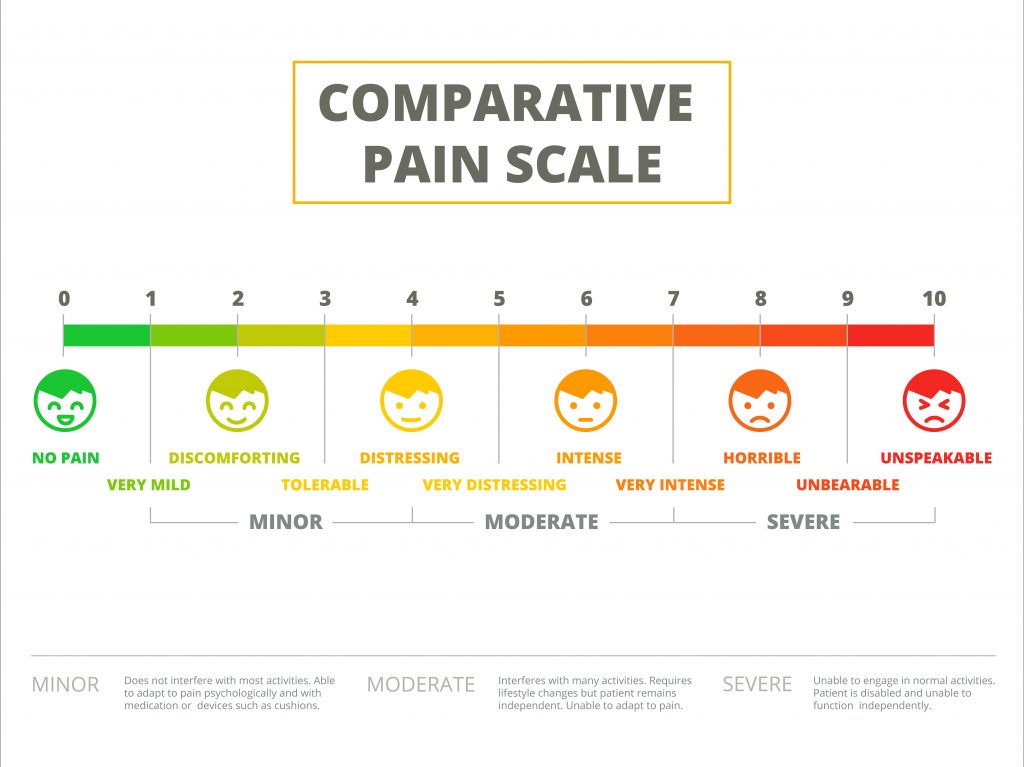
Sep 30, 2021
Paingone
Understanding Pain Scales and How to Use Them
Describing your pain level to your doctor can be difficult. Pain, while very real, is hard to convey to others because there are so many pain levels, and describing how much pain you’re in is a subjective process. In response, most physicians now use a pain scale to help people accurately relay their pain level to others. If you suffer from chronic pain or migraines, you’ve probably used a pain scale more than once. The issue is complicated because there are several different versions of the pain scale currently in use. Still, when used properly, a pain scale can help others understand the severity, duration, and kind of pain you’re experiencing.
Unidimensional Pain Scales
These are the most commonly used pain scales and rate the level of intensity of pain at any given time. You are asked to indicate your pain level using a sliding scale from no discomfort to the most intense pain imaginable.
Numeric pain scales rank pain from one (no pain) to ten (unbearable pain). Along this range, doctors often group pain levels into none, mild, moderate, and severe. Four to six is considered moderate. This is the most commonly used pain scale today because it’s simple and easy to use. Your doctor can also compare your score from one visit to the next to see how much your discomfort fluctuates and whether it is improving or getting worse over time.
Another version of the numeric scale is a categorical pain scale, which breaks down the pain levels into a range from one to ten and assigns specific descriptions to each level. Patients choose the words that are closest to what they are experiencing. Some categorical pain scales also assign simple faces to each level, illustrating the severity of the pain. A smiling face represents no pain, while a crying face symbolizes the worst pain possible.

A verbal pain intensity scale allows patients to express their pain level in words such as uncomfortable, distressing, or excruciating. However, without a baseline comparison, this method may not be as accurate because people define pain differently with words, and what a descriptor means to one person may not be the same. What “mild” means to you may mean “moderate” to someone else.
Multidimensional Pain Scales
These tools gauge pain across more than one parameter, which gives your physician a more thorough understanding of your pain experience, but multidimensional scales aren’t used as often as the more common unidimensional pain scales.
The most commonly used multidimensional scale is an initial pain assessment. A patient indicates the level of pain, but where it is located and its impact on their daily life. Using a diagram of the human body, patients show where the pain is, then use a simple pain scale to rate the pain level for each area. Finally, the patient fills out a comment section to indicate any particular pain-related issues and how their pain is affecting them.
A brief pain inventory is similar to an initial pain assessment but is more straightforward and quicker. It’s usually a one-page inventory of how you’ve been feeling by asking several questions about your pain level in the previous twenty-four hours. This is often used for acute rather than chronic pain.
The most popular of the multidimensional evaluation methods is the McGill Pain Index. A detailed questionnaire assesses pin intensity and type based on the words chosen from a list to describe pain levels. Patients select the words that most accurately describe their pain experience from a list of 78 words. Depending on the words chosen, they may express different aspects of pain, such as affective, sensory, and evaluative.
Headache Impact Test
Unique among pain scales is one used to evaluate headache pain and its impact on daily life. This pain scale is endorsed by the National Headache Association and used by many neurologists and headache specialists to assess pain level and its impact on everything from social life to workability and sleep patterns. The Headache Impact Test (HIT-6) is based on the responses to a set of six questions.
How Pain Scales are Used
Which pain scales are used and when doctors use them depends on a variety of factors. A multidimensional pain scale is often used during an initial consultation to get a more comprehensive picture of your pain level. This is especially important with chronic or widespread pain. For acute pain or as periodic follow-ups, simpler pain scales may be used. The categorical pain scale is one of the most common choices when working with children who are in pain because it’s easy to understand and gives clear parameters.
If your doctor hasn’t used a pain scale to help understand your pain, talk to them about using one on your next visit. Giving them a clear snapshot of your experience can help them more effectively treat your pain.
Is Paingone helping your patients and your practice?
Tell us your success story.
A robust retail strategy is essential to growing your practice.
You only have so many hours a week available for appointments. The fastest way to increase your bottom line is to incorporate profitable products that generate repeat business and build your reputation as a medical professional. That’s where Paingone comes in.
Contact us below to learn more about our products, wholesale pricing and how Paingone can benefit your practice.

